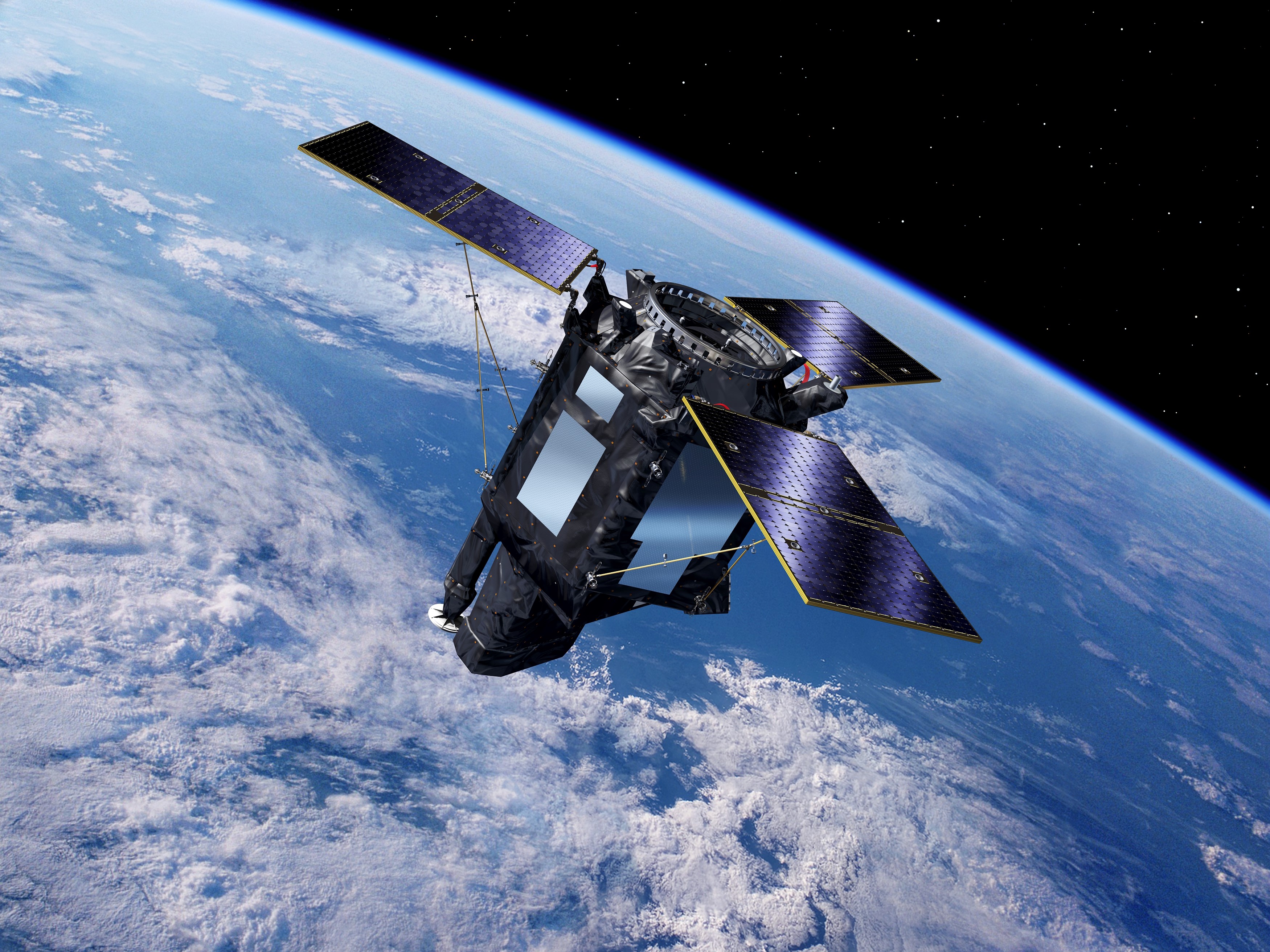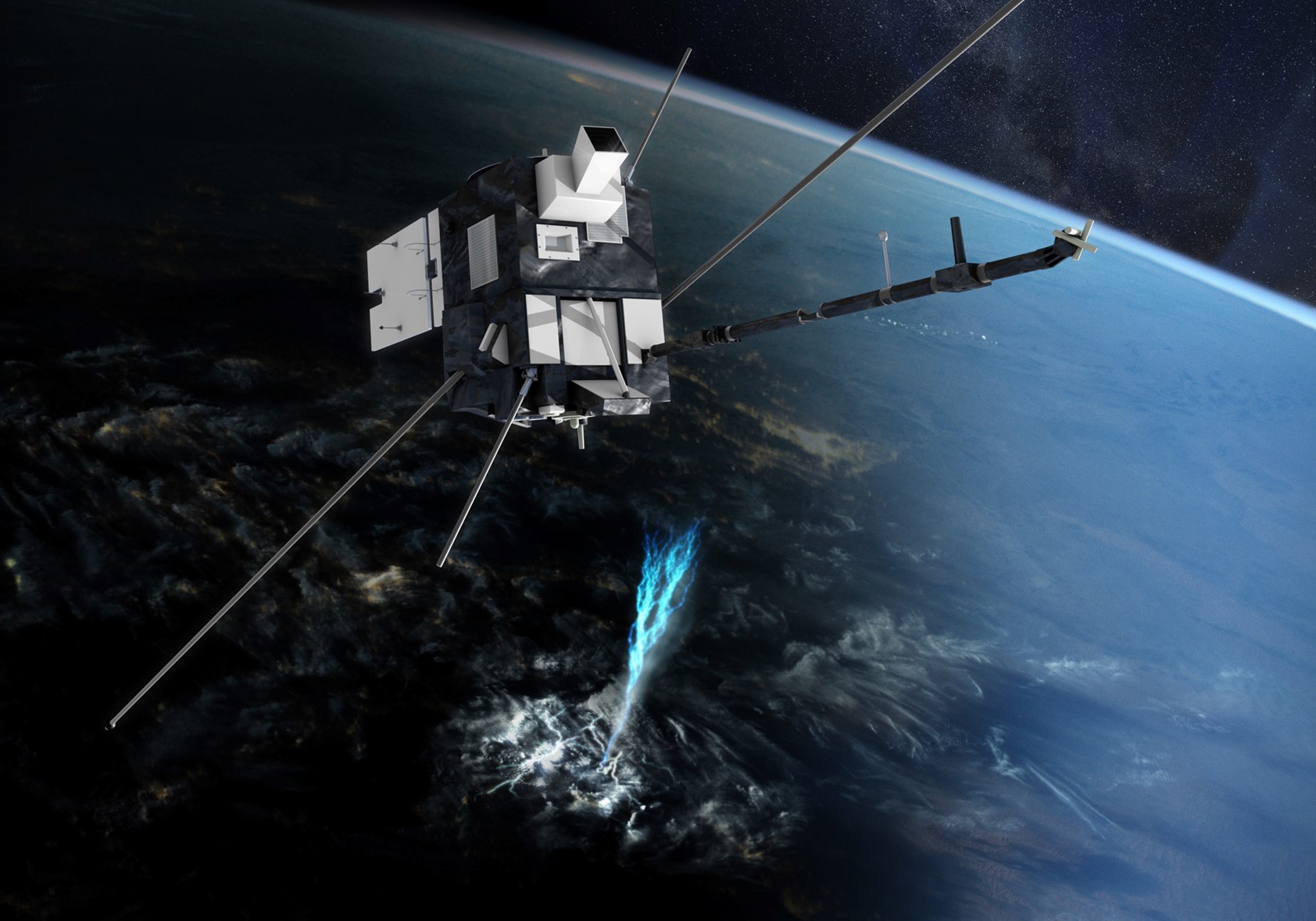Vega znów zawiodła 17.11. o 01:52:20 z Kourou wystrzelona została RN Vega, która miała wynieść w T+54' na orbitę o parametrach:
hp=670 km, ha=670 km, i=98,09° hiszpańskiego satelitę teledetekcyjnego SEOSAT-Ingenio, a w T+1h 38' na orbitę
o parametrach: hp=676 km, ha=676 km, i=98,19° francuskiego satelitę naukowego TARANIS. (Tool for the Analysis
of RAdiation from lightNIng and Sprites).
Pierwsze trzy stopnie RN funkcjonowały prawidłowo, natomiast zaraz po uruchomieniu stopnia AVUM trajektoria lotu zaczęła się znacząco obniżać w stosunku do zaplanowanej. Misja zakończyła się fiaskiem. Podejrzewa się, że winę ponosi błędne podłączenie kabli sterujących pracą siłowników, poruszających dyszę silnika RD-869.http://lk.astronautilus.pl/n201116.htm#02
Payload profile: Spain’s #SEOSAT-Ingenio – to be released first during the launch sequence – is an Earth observation satellite that support applications in cartography, land use, urban management, water management, environmental monitoring, risk management & security.
https://twitter.com/Arianespace/status/1328439636688052225
Advancing space science: #TARANIS of France, whose separation will complete Vega Flight #VV17, is the 1st satellite designed to observe luminous, radiative and electromagnetic phenomena (called “sprites,” “jets” and “elves”) occurring at 20-100 km above thunderstorms.
https://twitter.com/Arianespace/status/1328447768965378054Vega launches SEOSAT-Ingenio and TARANIS23 134 wyświetlenia•17 lis 2020
Vega VV17 – nieudany lot BY KRZYSZTOF KANAWKA ON 17 LISTOPADA 2020
(...) Vega to obecnie najmniejsza europejska rakieta nośna. Jej wejście do służby nastąpiło w 2012 roku (wówczas na orbitę został wyniesiony pierwszy polski satelita PW-Sat). W piętnastym starcie (lipiec 2019) rakieta Vega po raz pierwszy zawiodła. Kolejny start Vegi (3 września 2020) był udany.
Siedemnastego listopada 2020 o godzinie 02:51 CET z kosmodromu Kourou w Gujanie Francuskiej wystartowała rakieta Vega. Na jej pokładzie znalazły się dwa satelity: SEOSat-Ingenio oraz TARANIS. Był to siedemnasty start rakiety Vega (VV17)
Prace trzech dolnych stopni przebiegały prawidłowo. Tuż po odpaleniu czwartego stopnia (AVUM) zaczęły się problemy – zanotowano “degradację” trajektorii (w tym przypadku obniżanie się zamiast dalszego wznoszenia). Arianespace na oficjalnie poinformował, że nastąpiła wspomniana degradacja trajektorii po 20 minucie lotu, choć kilka minut wcześniej na grafikach prezentowanych w trakcie przekazu można było zobaczyć nieprawidłowy ruch górnego stopnia. Satelity zostały utracone.
Jest to już dziewiąty nieudany start rakiety orbitalnej w 2020 roku. Tak złej passy w ilościach nieudanych startów nie było od lat 70. XX wieku. Nieudane starty dotknęły w tym roku zarówno Europę, jak i USA, Chiny i Iran.
(PFA)
(...)
https://kosmonauta.net/2020/11/vega-vv17-nieudany-lot/Arianespace o powodach utraty ładunku Vegi. Możliwa „seria ludzkich błędów”20 listopada 2020, 14:47
Przyczyny drugiego nieudanego startu rakiety Vega, na pokładzie której znajdowały się dwa satelity (w tym jeden współtworzony przez Polaków), bada już specjalna komisja powołana przez Europejską Agencję Kosmiczną oraz spółkę Arianespace. Co ciekawe, jeszcze przed właściwym rozpoczęciem jej działalności przedstawiciele europejskiego operatora systemów nośnych wskazali, że za porażką misji VV17 może stać seria ludzkich błędów.Druga w historii nieudana misja europejskiego systemu nośnego Vega kosztowała utratę ładunku złożonego z dwóch instrumentów satelitarnych: hiszpańskiego SEOSat-Ingenio (satelita obserwacji Ziemi) oraz francuskiego badawczego systemu Taranis. Problemy nastąpiły po zainicjowaniu zapłonu silnika czwartego stopnia - doszło do utraty prędkości i zmiany trajektorii lotu rakiety. Według opisu zdarzenia, miało dojść wręcz do "koziołkowania" ładunku na orbicie.
Wobec takiego przebiegu misji sprawą zajęła się już nowo powołana komisja dochodzeniowa z udziałem przedstawicieli Europejskiej Agencji Kosmicznej i operatora rakiety, firmy Arianespace. W jej skład weszli m.in. Daniel Neuenschwander, dyrektor sekcji Transportu Kosmicznego ESA oraz Stéphane Israël, dyrektor generalny Arianespace. Komisja rozpoczęła działanie już 18 listopada, dzień po katastrofie. "Wiele wskazuje na to, że była to seria ludzkich błędów, a nie problemy techniczne" - skomentował już na wstępnym etapie działań Roland Lagier, szef zespołu technicznego Arianespace.
Wstępna analiza telemetrii lotu w połączeniu z danymi technicznymi rakiety doprowadziła zespół Arianespace badający przyczynę katastrofy do wniosku, że mogło dojść do pomyłki w podłączeniu sterowania uruchamiającego silnik w module AVUM (czwarty segment silnikowy). Są to przy tym wciąż wstępne wnioski.
"Jestem myślami z wszystkimi zespołami, które pracowały przy obu utraconych satelitach, ze wszystkimi ludźmi, którzy włożyli wiele trudu w powstanie SeoSat-Ingenio i Taranisa" - powiedział dyrektor generalny ESA, Jan Wörner. "Zapewniam, że osobiście zaangażuję się w wyjaśnienie przyczyn wypadku" - dodał.
Mierząca 30 m długości rakieta nośna Vega wystartowała z kosmodromu w Gujanie Francuskiej w nocy z 16 na 17 listopada. Był to drugi tegoroczny start rakiety Vega, która weszła do użycia w 2012 roku, ale od lipca 2019 przez ponad rok jej użycie było wstrzymane z powodu zaistniałego wówczas pierwszego nieudanego startu. Tamta sytuacja była wynikiem problemów z drugim stopniem rakiety - doszło do katastrofy i utraty Vegi wraz z ładunkiem. Usterkę udało się ustalić i naprawić, a Vega powróciła do użytku jako jedna z kluczowych rakiet Grupy Ariane.
Ta sytuacja przypomina nam po raz kolejny, że obszar naszej działalności jest skomplikowany i że sukces od porażki dzieli bardzo cienka linia. Nasi specjaliści już zajęli się analizą danych ze startu, by zrozumieć powód, dla którego misja się nie powiodła oraz pomóc naprawić usterkę tak szybko, jak to tylko możliwe. Jean-Yves Le Gall, dyrektor francuskiego Narodowego Centrum Badań Kosmicznych CNES
To właśnie CNES był pomysłodawcą i głównym koordynatorem prac nad mikrosatelitą Taranis, którego celem było zbadanie wysokoenergetycznych wyładowań w górnych warstwach atmosfery, tzw. zjawisk TLE (Transient Luminous Events) oraz krótkotrwałych rozbłysków promieniowania gamma w ziemskiej atmosferze (Terrestial Gamma-ray Flashes, TGF). Centrum Badań Kosmicznych Polskiej Akademii Nauk powstał zasilacz będący częścią systemu MEXIC (Multi Experiment Interface Controller), mózgu całego skomplikowanego układu instrumentów naukowych.
W przygotowanie instrumentów dla misji Taranis włożyliśmy dużo czasu i jeszcze więcej pracy. Przykro mi, że zespół naukowy nie uzyska oczekiwanych danych, że satelita nie dokona pomiarów. To wielka strata dla nauki. Jednak z punktu widzenia inżynierskiego możemy mimo wszystko mówić o sukcesie. Współpraca ze znakomitymi inżynierami z CNES otworzyła CBK PAN na nowoczesne trendy w projektowaniu elektroniki wykorzystywanej do eksploracji kosmosu. Doświadczenie, nowe umiejętności i kontakty, jakie nawiązaliśmy przy okazji pracy nad Taranisem są bezcenne. Dr inż. Roman Wawrzaszek z CBK PAN
"Wciąż nie uzyskaliśmy informacji, czy CNES zdecyduje się na drugie podejście do projektu i ponowne skonstruowanie satelity. Jeśli tak, to może liczyć na naszą współpracę" - mówi profesor Jan Błęcki z CBK PAN, Co-Leading Investigator misji Taranis.
https://www.space24.pl/wiadomosci/arianespace-o-powodach-utraty-ladunku-vegi-mozliwa-seria-ludzkich-bledowhttps://www.space24.pl/wiadomosci/rekordowe-straty-ubezpieczycieli-po-upadku-rakiety-vega-widmo-rynkowego-exodusuEuropean Vega rocket suffers second failure in three launchesNovember 17, 2020 Stephen Clark
 A Vega rocket took off Monday night from French Guiana with two European satellites, but the launcher failed to deploy the payloads into orbit. Credit: Arianespace
A Vega rocket took off Monday night from French Guiana with two European satellites, but the launcher failed to deploy the payloads into orbit. Credit: ArianespaceA European Vega rocket crashed back to Earth shortly after launching from French Guiana carrying a Spanish land imaging satellite and a French research probe with a combined value of nearly $400 million. (...)
The French Taranis research satellite was designed to trace the origins of mysterious luminous phenomena above thunderstorms. These Transient Luminous Events, or TLEs, are electrical discharges that last just milliseconds, and scientists are unsure of the mechanisms and physics the produce them.
TLEs manifesting themselves as red sprites and blue jets are sometimes visible on dark nights, especially from aircraft. Phenomena known as elves are the most difficult to detect, requiring special photographic equipment.
Long theorized with sporadic observations which were spread by word-of-mouth, bright electrical bursts above thunderstorms were first documented in 1989 by ground-based observations and instruments on the space shuttle. Scientists know little about how the discharges are triggered, or how they reach so high in the atmosphere, near the edge of space.
 The SEOSat-Ingenio Earth observation satellite is seen mounted on top of the Vega rocket’s Vespa dual-payload adapter before encapsulation inside the payload shroud. The French Taranis satellite is contained inside the Vespa structure. Credit: Airbus
The SEOSat-Ingenio Earth observation satellite is seen mounted on top of the Vega rocket’s Vespa dual-payload adapter before encapsulation inside the payload shroud. The French Taranis satellite is contained inside the Vespa structure. Credit: AirbusTaranis, led by the French space agency CNES, would have attempted to untangle what triggers these brief flashes above thunderstorms, and how TLEs might affect conditions within the atmosphere or in space.
The 385-pound (175-kilogram) Taranis satellite “will be capable of detecting these phenomena and recording their light and radiation signatures at fine resolution, as well as the electromagnetic disturbances they generate in the upper layers of Earth’s atmosphere,” CNES said in a press release before the failed launch.
The instruments aboard Taranis included cameras, X-ray and gamma-ray detectors, electron detectors, a magnetometer, and sensors to detect plasma and electric fields in space.
Built for a mission of two-to-four years, Taranis would have also studied Terrestrial Gamma-ray Flashes, or TGFs, brief bursts of gamma-ray photons observed emanating from thunderstorms around the world.
“Taranis is the first space mission combining optical, gamma, energetic particles and eletric and magnetic measurements to improve our understanding of these phenomena,” said Jean-Louis Pinçon, science lead for the Taranis mission from CNRS, the French national scientific research center. “Ultimately, once the generation mechanisms will be fully understood, we will have the possibility to estimate the real impacts of TLEs and TGFs on the physics and chemistry of the upper atmosphere.”
CNES spent about 115 million euros, or $136 million, on the Taranis project since it began in 2010, Pinçon said.
https://spaceflightnow.com/2020/11/17/european-vega-rocket-suffers-second-failure-in-three-launches/https://spacewatch.global/2020/11/vega-vv17-fails-taranis-and-seosat-ingenio-satellites-both-lost/https://www.arianespace.com/mission/vega-flight-vv17/SEOSAT-Ingenio
https://space.skyrocket.de/doc_sdat/seosat-ingenio.htmTARANIS
https://space.skyrocket.de/doc_sdat/taranis.htmhttps://www.nasaspaceflight.com/2020/11/arianespace-vega-seosat-taranis/AA
https://www.forum.kosmonauta.net/index.php?topic=3725.msg152858#msg152858